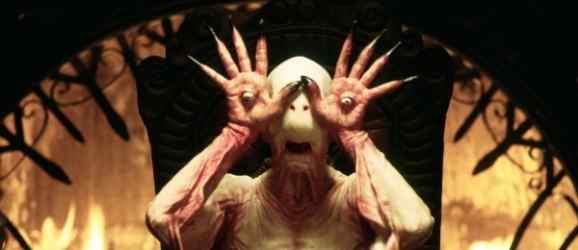Practical Effects: Making Monsters Tangible

Earlier this year, practical effects veteran Alec Gillis of Amalgamated Dynamics, Inc. (ADI), the company behind the special effects of Alien 3 and Death Becomes Her, began a Kickstarter project for a ‘full-length creature film that will feature only practical Animatronic and Makeup effects.’ Utilising a team of industry professionals assembled over a 25 year period, Gillis intends to craft a feature in the spirit of the creature based horror films of the 1980’s, when limitations on the capabilities of digital effects required a more artisanal approach to creating special effects.
This is not to say that Harbinger Down will be completely bereft of digital technology; the film will be shot and edited digitally, and small effects such as breath vapour and the compositing of puppets are deemed ‘appropriate uses of digital’. It is not that Gillis and his team are opposed to the use of digital SFX; Gillis acknowledges that CGI is advantageous in the creation of expansive worlds and large scale, visually striking effects. His aim, with Harbinger Down, is to recapture the spirit of such creature features as The Thing and Alien, where necessity dictated a focus on enclosed spaces and the psychology of the characters rather than the depiction of the creature, à la Pacific Rim.
Before digital effects evolved to the point where relatively convincing monsters could be created on screen, they were most memorably portrayed by stop-motion puppets, as in the work of Ray Harryhausen, by a costumed actor in Ishirō Honda’s Godzilla, or in the case of Disney’s Pete’s Dragon, with 2D animation. Indeed, special effects have been a part of cinema since its earliest days, perhaps most notably in the films of magician-turned-filmmaker Georges Méliès; having accidentally discovered the ‘stop trick’ technique whilst filming traffic in 1896, Méliès is widely cited as the ‘grandfather of special effects’ for his use of superimpositions, dissolves, double exposure, and stop-motion.
In more recent years, the landscape of visual effects has been shaped in no small part by likes of Industrial Light & Magic, a division of Lucasfilm that George Lucas opened in 1975 in preparation for the filming of Star Wars. Accruing an impressive collection of 23 Sci-Tech Awards and 15 Oscars over the 275 films the company has worked on since its inception, ILM has become something of a giant in the visual effects world; Lucas’ company have produced visual effects for a plethora of films, from Ironman, Pirates of the Caribbean, and the Harry Potter films of the last decade through to Cocoon and Poltergeist in the 80’s.
However, just as Lucasfilm, and indeed Lucas himself, are perhaps best known for the Star Wars films, it is the array of puppets and animatronics crafted for the trilogy that are among the most memorable of Star Wars‘ visual effects. Despite Lucas’ apparent efforts to erase the practical effects in his work by replacing them with CGI in re-releases of the films, who can forget Stuart Freeborn’s iconic Yoda, voiced and manipulated by Frank Oz, or the lumbering stop-motion gait of the AT-ATs?
What we remember is the wizened little gremlin with the huge ears, skewed sense of syntax and a voice familiar from Oz’s work on The Muppet Show. Impressive and innovative though the digital effects of the films are, it is the intensely haptic nature of the Yoda puppet that makes it the more engaging; the textured skin of the puppet with its wrinkles and frizzy hair, and the mobility of the face which make it so expressive, so animated, easily convince the audience to consider Yoda in the same light as Hamill, as an actor rather than a prop.

Whilst it can’t really be argued that the CGI incarnation of the Jedi master isn’t more practical in scenes which require him to be mobile, he is rarely so until Attack of the Clones. Until 2002 Yoda was rarely seen to be much more than stationary or moving at a slow shuffle, and so was easily portrayed in puppet form, generally framed in a midshot or close-up, which allowed for Oz’s masterful puppetry and manipulation of the expressive face. But what makes the original Yoda preferable, if perhaps not superior, to the updated CGI incarnation of the digital re-releases?
His physical presence.
The issue with inserting a wholly digital character into a live action film is the compositing. Whilst the character design and animation may be top notch, the insertion must still be convincingly integrated into the physical world of the film; two realities must be successfully combined into one. Animated movements often appear exaggerated alongside those of an actor, and despite the photorealistic capabilities of today’s technology a complete unity of style between CGI and reality is difficult if not impossible to achieve.
The advantage to using puppets and animatronics is that they already exist in the same reality as the actor and can interact with the actor within the same temporal space, whereas a CGI character must be inserted during post-production. The puppets, of course, must still be masterfully crafted and manipulated in order to don the semblance of life, but with some directorial ingenuity in terms of the cinematography, they can be made into a strong on-screen presence.
I don’t mean to disparage the use of CGI – it can be used to great effect, and there are plenty of instances where practical effects have yielded cringe worthy results – but it certainly seems to have become the case that directors reach for CGI without giving any consideration to practical effects. Certainly, it’s easier to make changes to a scene with CGI than with puppets because it can be done in post-production without the need to re-shoot. As Gillis points out:
On the big movies when there’s a challenge, the solution is often to throw money at it. Response cards unfavorable after a test screening? Change the ending and spend 3 million on re-shoots. Smaller films have challenges too, but the solution is never to throw huge amounts of money at them. So you have to be smart. You have to pre-plan a bit more. And you certainly can’t spend money on costly digital effects aimed at distracting the audience from noticing that the film just isn’t working.
The trick is to avoid complacence; because many of the limitations which impeded Ridley Scott in Alien and led to his changing his approach in the way he filmed the creature have been overcome, directors no longer have to be quite so creative. Fewer problems means less problem solving, and so less thinking outside the box when it comes to filming; CGI’ll fix it.
Indeed, some of the best examples of special effects were in the 80’s and 90’s whilst the capabilities of CG were still being showcased. Take Spielberg’s Jurassic Park, for example; released in 1993, blockbuster featured prehistoric monsters created variously with CG, animatronics, and actors in painstakingly crafted costumes. ‘The goal of Muren and his fellow special effects artists’, writes David Morgan, ‘ is to help the audience forget that they are watching a movie — to convince them that dinosaurs do exist.’
The success of the dinosaurs in Spielberg’s film stems from the fact that the effects that created them were chosen according to the needs of the shot; for the most part, CG was reserved for full body shots of the larger dinosaurs, or instances in which a number of the beasts were shown onscreen. The raptors, on the other hand, were portrayed by Stan Winston Studio supervisor John Rosengrant and concept designer Mark “Crash” McCreery:
The tension of the “Kitchen Attack” scene is so palpable because, like Yoda, the raptors have a definite physical presence. Spielberg utilises a combination of practical and digital effects to bring the dinosaurs to life, interchanging between Rosengrant in his suit and CG versions of the beasts when more complex movements are required. The effect is to portray the dinosaurs as extremely agile and intelligent, but most importantly living predators of which the children have every reason to be terrified.
In more recent years the puppet scene has been left largely to Mexican director Guillermo del Toro, best known by English speaking audiences for his Oscar winning Pan’s Labyrinth of 2006. Having trained in special effects and make-up with senior SFX artist Dick Smith, del Toro’s first venture onto the big screen was Cronos in 1993 which carried off the Critics Week Award at Cannes, as well as nine Mexican Academy Awards. In addition to his Spanish speaking films, he has since gone on to direct comic book adaptations Blade II, Hellboy and Hellboy 2: The Golden Army, bringing them to life with his own stylised practical effects.

Pan’s Labyrinth is notable for its use of primarily practical effects, digital effects being used mostly in post-production to erase, for instance, the legs of Doug Jones who played both the Faun and the Pale Man. Del Toro wanted the figure of the Faun to be as organic as possible, and the body of the latex costume is covered in whorls and gnarls suggestive of aged wood, the physical presence of the creature on screen serving to strengthen the link between the Faun and his surroundings. The Pale Man, too, was a costume crafted of latex foam, Jones being able to see only through the creature’s nostrils; even the mandrake was a combination of animatronics and CGI. The faeries, of necessity, were CGI, flitting about the screen as they do.
However, del Toro’s latest film, Pacific Rim, relies heavily on CGI to create the massive ‘Kaiju’ creatures and the robotic ‘Jaegers’ designed to combat them. Given his propensity toward practical effects, it may seem odd that del Toro has signed on to direct a film so heavily reliant on computer graphics, but it’s all a question of scale. Whereas costumes and animatronics can be used to great effect when the creatures are roughly of a scale with their surroundings, portraying giant monsters in such a fashion would require filming with miniature sets and costumed actors à la Godzilla.
And it’s on a larger scale that the capabilities of CGI really come into play; computer graphics can create whole expansive worlds and effects on a scale that would be practically impossible with traditional techniques, such as in the slew of apocalyptic disaster movies of recent years. Scale, and the practicalities of working with it, are perhaps the deciding factors. In instances such as those of the films above, Star Wars and Pan’s Labyrinth, where the creatures are roughly of a size with their human counterparts, costumes, prosthetics and animatronics can be used to great effect. Conversely, CGI is the more practical choice when creating effects on a larger scale, such as huge monsters or cataclysmic disasters.
Practical effects, like many of the traditional practices in filmmaking, appear to be dying out in the face of new technologies. But they shouldn’t be; CGI, despite its fantastic capabilities, is not a cure all when the most important thing about special effects is how believable they are. We enter into a film in the knowledge that we are watching a fictional construct, and yet it jars when the reality of the film is derailed by special effects which call too much attention to their artifice.
A balance should be struck between traditional and digital effects, and discretion shown in the director’s decisions to use which effects where. With Gillis set to make his film on a budget of $384, 181, larger films should have no budgetary issues with incorporating practical effects where they prove most effective, and using CG where practical or required rather than as a cinematic fail-safe.
What do you think? Leave a comment.











Awesome article! Let me start by admitting that the spaceship discovery in 2001: A Space Odyssey is one of my all time favourite sequences, I still believe that there is a time and place for each effect. Some scenes work better with CGI while others, many others, should be made in special effects. This is for the big productions though. We know that special effects costs and creating a space drama on a low budget… well 🙂
The effects in 2001 are lovely, and the majority, I think, were done with traditional techniques. Another sci-fi I love the effects of is Blade Runner; most of it was done with table top set pieces, models, and projected backdrops. Great stuff.
I actually supported that kickstarter campaign. Extremely excited to see what Gillis will do! Bring back the SE!
Nice! I wanted to, but y’know, student finance…I’m hoping they get a theatrical release, though. If Iron Sky managed it, briefly, so they should make it.
This is an interesting article. I imagine that as our society becomes more digitised, computer-based and ephemeral there will be a nostalgic and critical return to a more physical and tangible existence. For example, more and more modern bands are releasing vinyl and modern films are returning to puppetry or costumes. I imagine it is a way of coping with social insecurity. However, if it teaches us the practical and aesthetic qualities of a physical, crafted and less discardable culture, it may be quite useful. Thanks for posting!
Nostalgia seems to be the word of the day, and given the current love of all things ‘classic’ or ‘retro’, I imagine most of these things will make some sort of return eventually. Harbinger Down is the professionals reminding us what their techniques can do, ParaNorman is a love letter to old horror movies, and The Artist was a a celebration of silent film. Trends, I think, are circular after a fashion.
Excellent and well informed article, a great read!
I’ve always preferred prosthetics and animatronics for the exact reason you say here, they just look and feel more “real”. Giving actors something physical to work with must make their job easier. It’s one of the many reasons why the Star Wars prequels feel so empty and vacuous, because the actors have no sense of their environment or even at times what other characters are in the scene with them.
Also some traditional effects can look a little wobbly at times but they just have more character and charm than CGI. CGI has it’s uses as you say for post-production tweaking but I’d rather see effects like those in Cronenberg’s The Fly than those in Man of Steel.
Traditional effects can look, as you say, a little wobbly but that’s often part of the appeal. I was watching Gremlins the other day, and it was suggested to me that it would work better with CGI, which I completely disagreed with; the puppets are what make the film.
And you’re right, too, about giving the actors something to work with; whilst researching this article I found a video on YouTube for the making of 2012. Not, from what I’ve heard, a great film, but they made moving platforms to create the earthquake effects rather than just have the actors pretending the ground is shaking, and I respect that. The director wanted a realistic portrayal of reactions to an earthquake, and he got them.
Here’s the clip, if you’re interested:
http://www.youtube.com/watch?v=cg_tDItLYbk
Interesting article! Currently arguing the case for practical effects in my MA thesis comparing John Carpenter’s The Thing and the prequel from 2011 – there is, as you say, something about the solidity and physical presence that just cannot be beaten! Thoroughly enjoyable read !
Thanks! That sounds like an interesting read. I haven’t actually seen the 2011 film, but perhaps I should for comparison’s sake.
Top article. For me, Jurassic Park still looks more realistic than most effects-heavy movies nowadays. The dinosaurs had weight, even the CGI ones. I’ve also got a lot of respect for Del Toro and his team – I loved the way they blended practical and computer-generated effects for Sammael and the troll in the Hellboy series.
I think the thing with Jurassic Park was that the CGI was still relatively new, and hadn’t evolved to the point it’s at today; the dinosaurs looked real, and had weight as you say, but I think that today’s effects try for too much reality and overshoot the mark?
That’s the thing with del Toro, and a large part of my liking for his work: he prefers to use traditional techniques for his effects, probably due to his background in make-up etc, and uses CGI only where he really needs it.
lovely article. It is amazing how Jurassic parks dinosaurs still look better than a lot of the CGI beasties on our screens today. When it comes to CGI less is always more. There’s something more wholesome and aesthetically pleasing about physical effects. I know it’s not a monster movie but you’re article reminded me of Be Kind rewind and Michel Gondry’s love of creating really basic visual effects with limited money and a lot of ingenuity. Good stuff!
Thank you! You’re right, less is definitely more with CGI. I’d actually forgotten about Be Kind Rewind, I might track it down for a re-watch; I remember it being pretty funny!
Great article.
I agree that the Yoda effect had its issues. 2nd prequel was thin and insubstantial, but the Revenge of the Sith effect was much better. The puppet still felt more real.
This was so interesting! I’ve not thought much about film and TV special effects outside of CGI before. You’re totally right that the raptor’s physical presence definitely made that kitchen scene more frightening than CGI “monsters” often are because of their tangibility. Very illuminating!
Extremely insightful article and presented in an articulate manner. Great job.
This corresponds to the guiding principle of Occum’s Razor: the simplest solution generally is the best.